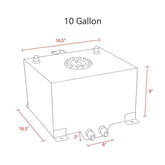Exhaust manifolds and headers serve a similar basic purpose in an engine's exhaust system but differ significantly in design, performance, and material composition. Here's a structured breakdown of their differences:
Design of exhaust manifolds and headers
First, in terms of design, exhaust manifolds are typically made of cast iron. They are molded in a way that makes them strong and durable, but also bulky and heavy. Their designs often focus on durability rather than optimal performance. On the other hand, headers are usually made of lighter materials such as stainless steel or aluminum. They feature separate tubes for each cylinder that merge into a collector, which smooths the exhaust flow.
- Typically cast as a single piece.
- Have shorter, more restrictive pathways for exhaust gases.
- Focus on durability and basic function.
Headers:
- Comprise individual tubes (one per cylinder) that merge into a larger pipe known as the collector.
- Are designed for a smoother flow with equal-length tubes to optimize the exhaust pulse and reduce backpressure.
Material of exhaust manifolds and headers
Exhaust Manifolds: Typically made from cast iron, manifolds are molded in a way that makes them robust but also bulky and heavy. They often have a simpler design that is focused on durability rather than optimal performance.
Headers: Headers are usually crafted from lighter materials like stainless steel or aluminum. They feature individual tubes for each cylinder that merge into a collector, allowing for smoother exhaust flow.
Performance of exhaust manifolds and headers
Exhaust Manifolds:
Due to their heavier and more restrictive design, can create more backpressure, which can hinder engine performance and efficiency.
Designed to quickly expel exhaust gases but not necessarily in the most efficient manner, potentially impacting fuel economy and power.
Headers:
By reducing backpressure, headers can improve engine efficiency, horsepower, and torque.
The smoother exhaust flow allows the engine to breathe better, which can lead to increased performance and better engine responsiveness.
The sound of exhaust manifolds and headers
Exhaust Manifolds:
Generally produces a quieter exhaust note due to the thicker material which absorbs sound.
The restrictive flow can muffle the sound of the engine's exhaust pulses.
Headers:
Often leads to a louder, more aggressive exhaust note.
The design can amplify the sound of the engine, which many enthusiasts find appealing for performance vehicles.
Heat dissipation of exhaust manifolds and headers
Exhaust Manifolds:
The heavy cast iron construction retains more heat, which can contribute to higher under-hood temperatures and affect nearby components.
Headers:
Constructed of materials that dissipate heat more effectively; often they are also offered with ceramic coatings or heat wraps to further reduce heat transfer.
Exhaust manifolds and headers cost and installation
Exhaust Manifolds:
Cost: For most common vehicles, replacement exhaust manifolds typically range from $150-$300 for the part itself.
Installation: Labor at a shop is usually around $200-$400, considering about 2-3 hours of work. DIY eliminates labor costs, assuming you have the necessary tools.
Installation Process:
1. Detach the existing manifold.
2. Clean the engine surface.
3. Install a new gasket and bolt on the manifold.
4. Reconnect the exhaust piping.
Headers:
Cost: Aftermarket headers for a typical performance improvement might cost between $250-$600.
Installation: Professional installation can range from $300-$600 due to the potential need for custom modifications.
Installation Process:
1. Remove the old manifold.
2. Test-fit the headers and modify the exhaust if required.
3. Secure the headers with a new gasket and appropriate hardware.
4. Ensure proper connection to the exhaust system.
Notice:
1. Installation Complexity:
- Installing headers typically demands a higher level of mechanical expertise.
- Specialized tools may be necessary, especially if modifications to the exhaust system are needed.
2. Installation Duration:
- The process for fitting headers is generally more time-consuming than for manifolds, often requiring a full day or more.
3. Regulatory Compliance:
- It is essential to ensure that any headers installed are in compliance with local emissions standards to prevent legal issues and potential fines.
In essence, the exhaust manifold is engineered with a focus on long-term resilience and cost-efficient manufacturing, making it a pragmatic choice for those who value reliability and economy in their vehicle's operation. Conversely, headers are tailored for performance aficionados, providing an improved exhaust system flow, diminished backpressure, and a more robust exhaust note that resonates with driving enthusiasts. Ultimately, the decision hinges on the vehicle owner's individual preferences—whether the goal is to uphold a dependable and budget-friendly exhaust system or to elevate the vehicle's performance and acoustic characteristics.









